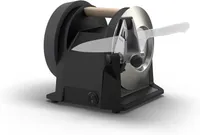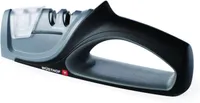I'm an ex chef — here's how I keep my knives razor sharp without a whetstone
Care about your knives? Keep reading
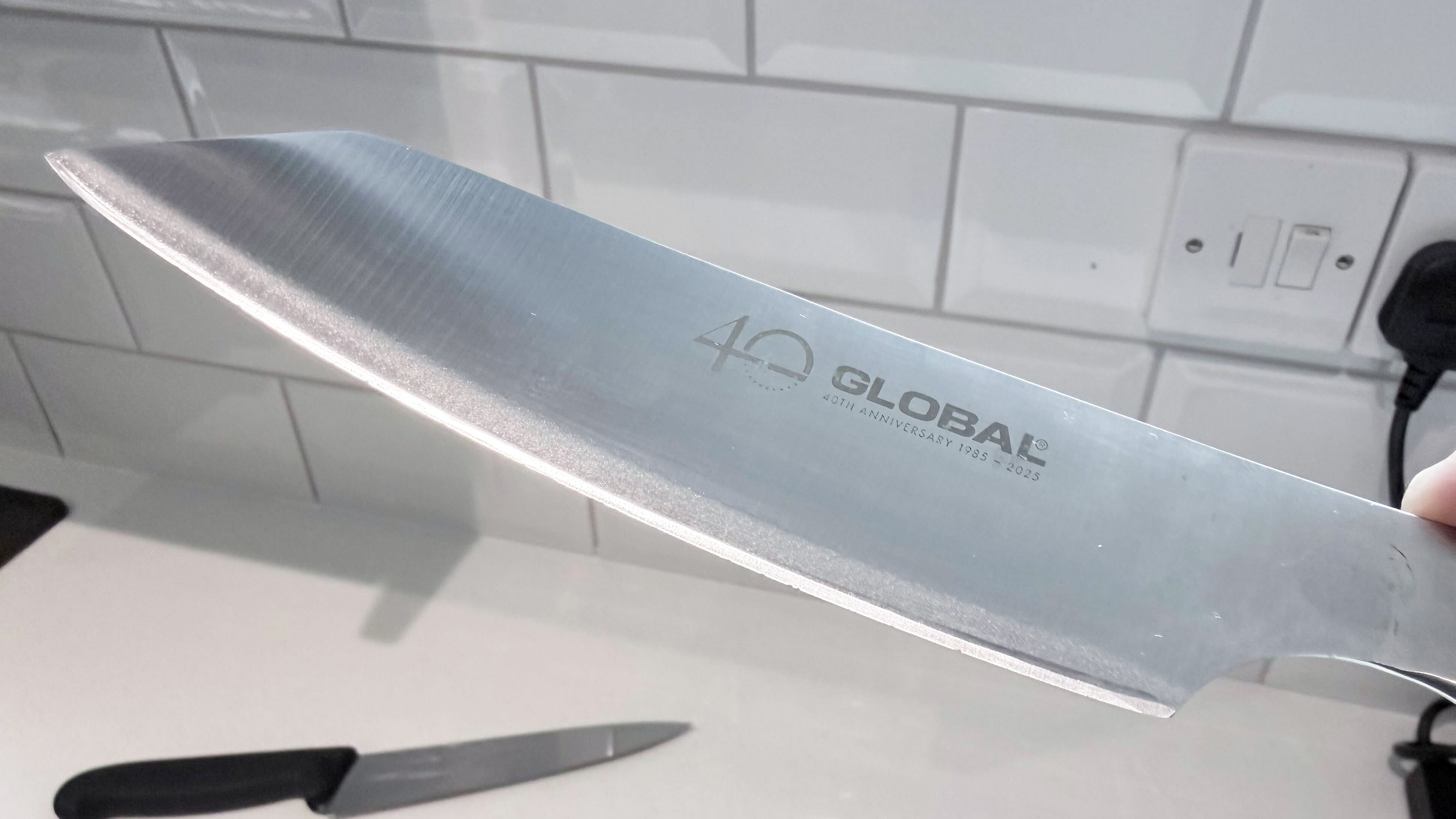
I have two sets of knives: one for me, and one for my wife and everyone else. Once upon a time, I was a classically trained chef. Through my training and professional practice, I learned the importance of keeping knives sharp.
Sharp knives are, perhaps counter-intuitively, far safer than dull ones. A dull knife is more likely to slip or bounce off whatever you’re trying to cut, hitting your hand or finger when it does. It’s also important to keep your knives sharp for longevity. Look after good knives and they’ll last you a lifetime. Avoid damaging them, hone them every use and sharpen them when required, and all you’ll ever need to do is basic maintenance to smooth out the odd nick or put back a slightly dull edge.
Anyone who owns and appreciates good knives will know all this. Unfortunately, that’s not most people. My knives are a set of meticulously maintained Wüsthof Classics that have served me excellently for over a decade, and will doubtless do at least a couple more. My communal knives, while also owned by me, are the ones that everyone else uses, and some of those are in a bit of a sorry state.
Thankfully, Tormek — a Swedish manufacturer that’s been making commercial sharpening tools since the 1970s — sent me its T-1 home knife sharpener to try and get them back into shape. And I can’t recommend it highly enough. It’s now become my default tool for keeping my knives honed on a daily basis, for periodic sharpening and for putting edges back on dull or damaged blades.
If your knives need some TLC, here’s why I think you should buy one.
My go-to method for honing, sharpening and even repairing knives. The Tormek T-1 features a diamond grind wheel and composite honing wheel. It also features a knife guard to ensure you achieve the perfect angle each and every time.
No skill required

One of the traditional ways to sharpen kitchen knives is by using a whetstone — a slab of stone that you soak in water and then run the knife across, to grind an edge into shape.
Honing, often done using a steel rod, is the process of smoothing out tiny nicks, edges and ridges that form on a blade’s edge during use, pushing them back into position to straighten the edge, removing no metal. Sharpening wears away the blade's metal to remove large nicks, restoring an edge or creating a new one. You hone every time you use the blade; you sharpen when the blade is dull or damaged.
The Tormek T-1 uses a sharpening wheel with a fine 600 grit to grind away an edge like a whetstone, only much faster, as the wheel surface is made from diamond rather than stone and is fully electrified. Accuracy is ensured by a locking angle guide that can be adjusted between 10 and 20 degrees, helping you achieve the same grind angle every single time. This removes the risk of messing up your angle on a whetstone and applying an uneven edge, which is very easy to do — you can use whetstone guides to help with this, but the Tormek still comes out on top here and proves much easier.
Get instant access to breaking news, the hottest reviews, great deals and helpful tips.
Simply put the knife in the guide, pull it backwards, et voilá. This removes the skill, yes, but I’m not some storied Japanese artisan — I don’t care about the process or tradition of whetstone-ing, I just want sharp knives as reliably and quickly as possible.
Another common type of tool are pull-through metal and ceramic sharpeners. These work well and are very reliable — I even use Wüsthof’s pull-through for my Wüsthof knives. However, these aren’t a catch-all solution. They’re a harsh way to sharpen as they work by shaving or planing away strips of metal.
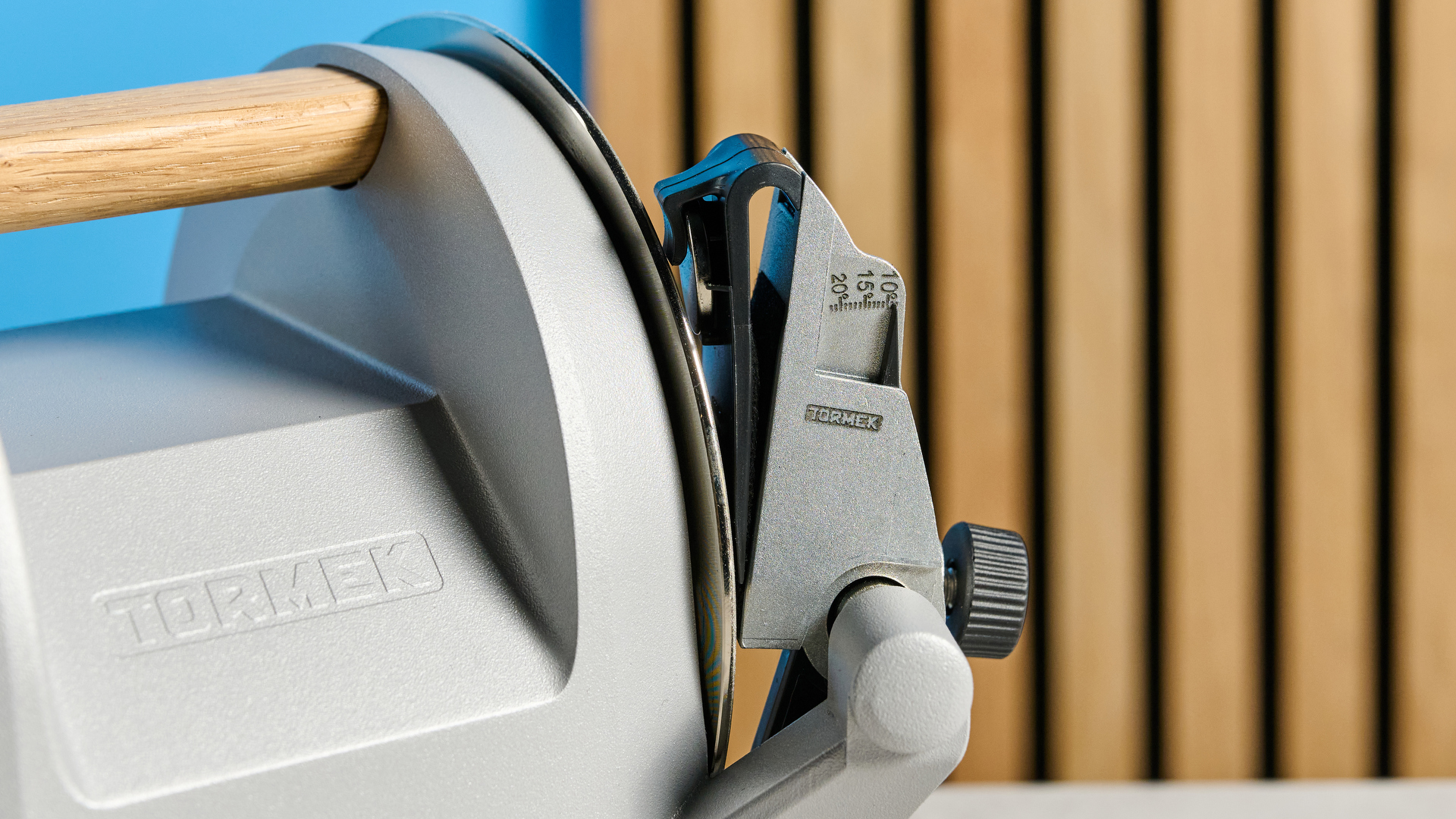
Put the wrong steel through them — steel that’s brittle for instance — and you can completely ruin a knife edge in just one or two pulls (the fate that had befallen my Victorinox chef’s knife). Once again, with its angle guide and more subtle diamond grinding wheel, the T-1 offers the ease-of-use of pull-through sharpeners without the same risk of damage.
Far from foolproof
While the Tormek T-1 is much, much easier to use than, well, any other sharpening method I’ve ever tried, it ain’t exactly foolproof. How do I know? Because I’m a fool, of course.
The first time I used the T-1, I didn’t realise the knife went inside the guide, so I ran it outside. This still works, but is much likelier to result in misalignment, and as such I scuffed up a knife pretty bad.

You can also wiggle knives inside the angle guide. Not by much, but enough to slightly change the angle and result in different edge profiles along the blade.
There’s also serious risk involved if you point your knife the wrong way when using either the diamond sharpening wheel or the composite honing wheel. This can result, at the very least, in your knife digging in and damaging either wheel. At worst, it can result in your knife firing back at you.
Naturally, common sense must prevail, which is advice that applies generally to handling knives anyway.
Professional results in minutes
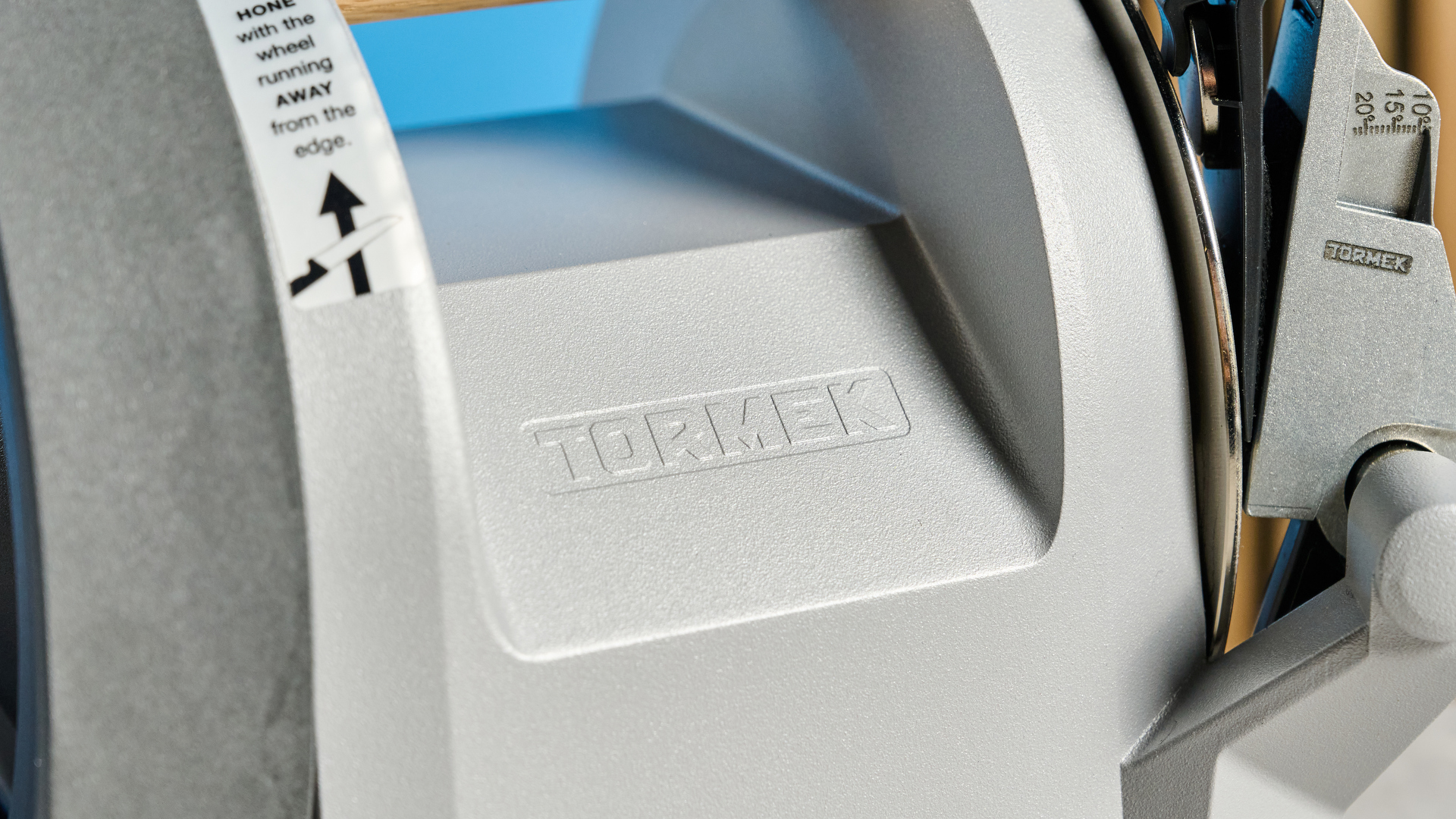
So, is it worth it? Good lord, yes. Once you’ve got the hang of the (very small) amount of pressure required when pulling knives through, it’s so easy to put edges back on dull blades.
Knife #1 — Wüsthof paring knife
I started on a slightly dull Wüsthof paring knife, which just needed its 18-degree edge sharpening. A few minutes was enough to put back a beautifully sharp edge and bevel.
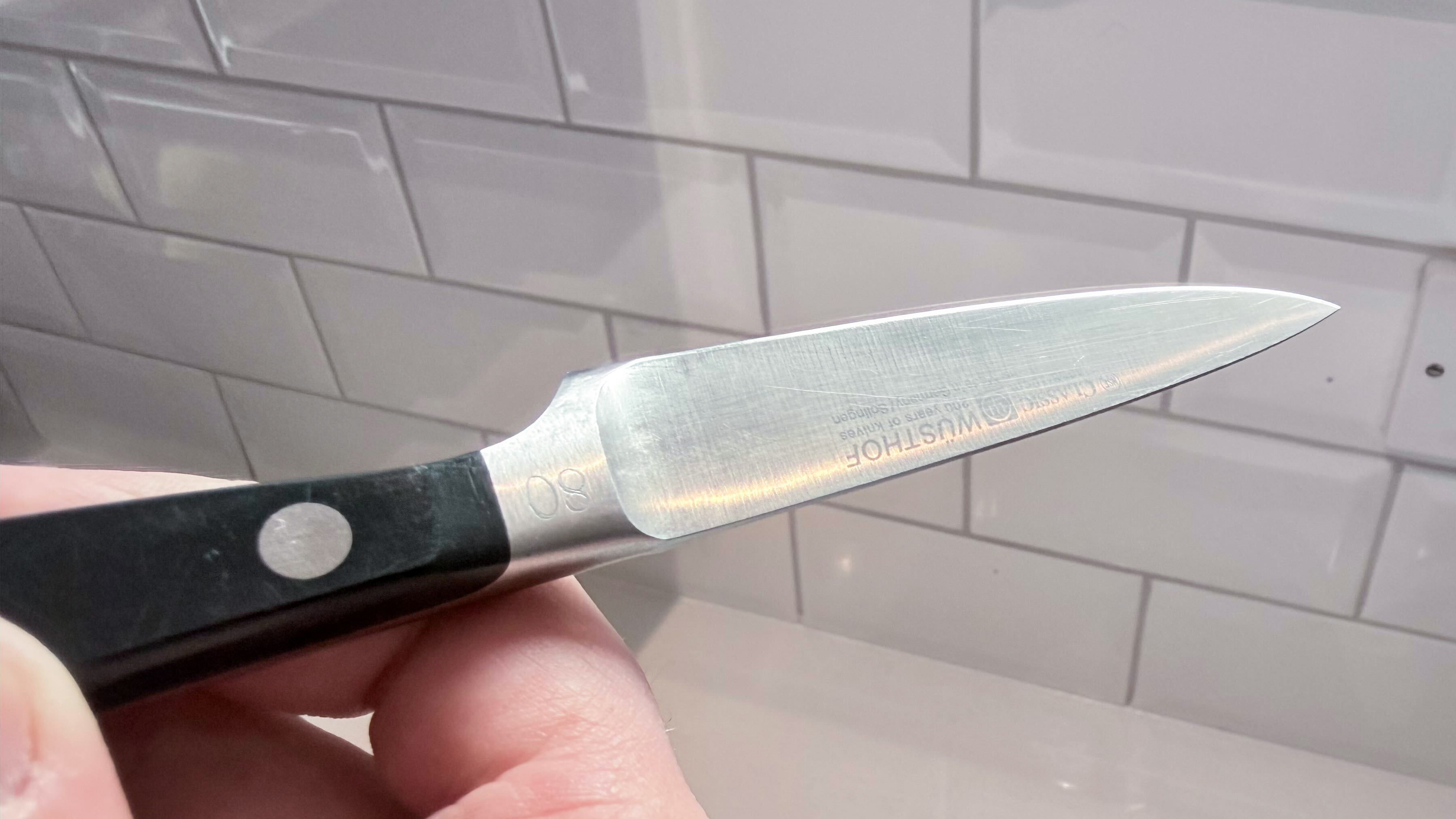
After four passes on one side, I could feel the blade burr on the other side, telling me that side was done and it was time to swap. After sharpening, I took the blade to the honing wheel, which also features a polishing agent, resulting in a brilliantly shiny and smoothed out bevel and edge.

I then moved onto two problem cases. The T-1 isn't designed to be used for repairing damaged blades regularly, but it can be used to do so... with some patience.
Knife #2 — Global Kiritsuke
First up, a moderate problem: my Global 40th Anniversary Kiritsuke, which has somehow unfortunately become one of the general knives in my house — and suffered for it.
In fairness, Global steel is pretty brittle and the edge angles are very thin, so this chef’s knife would've taken a beating just by existing anyway, even though it gets honed regularly (by me, at least).
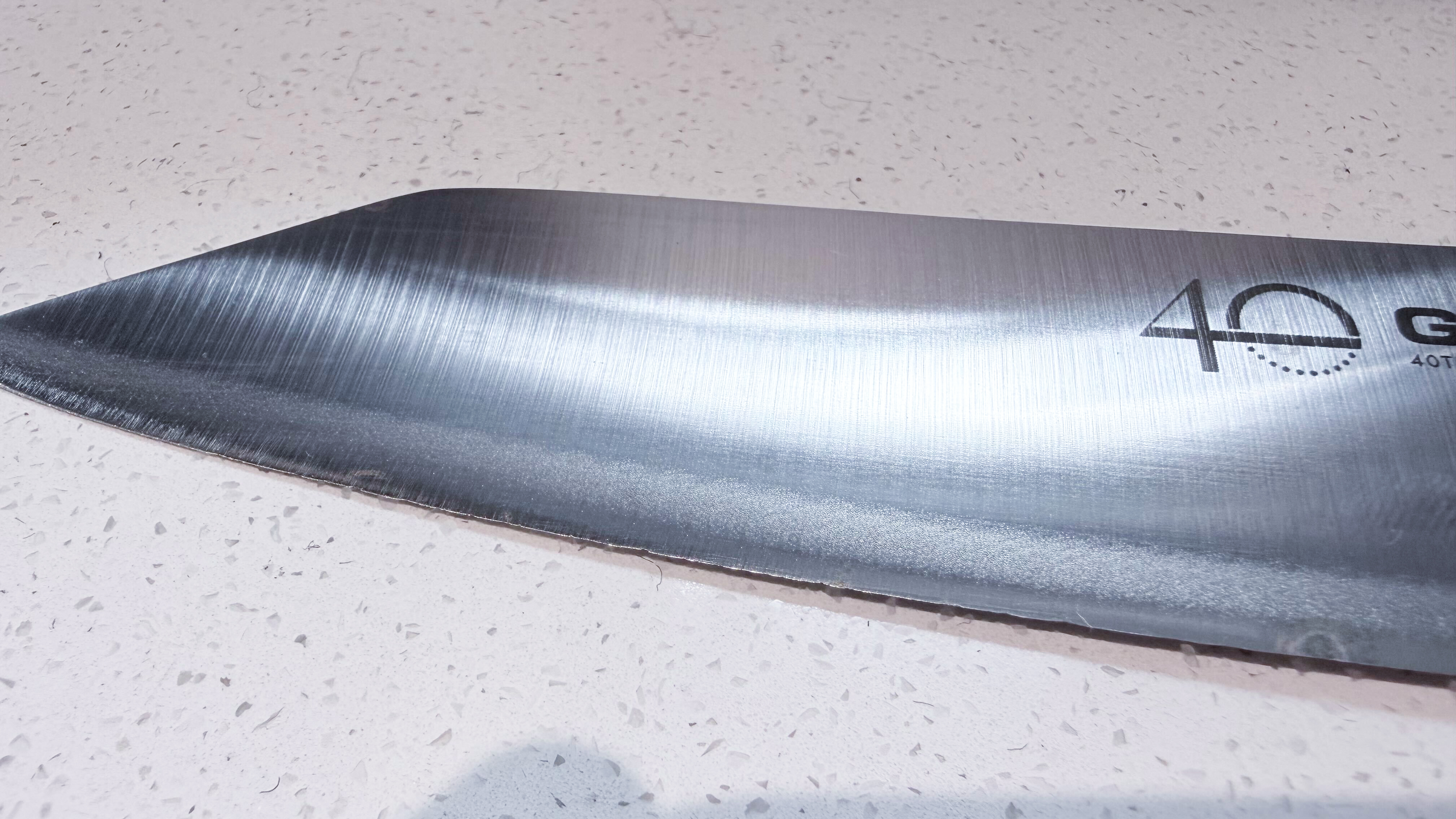
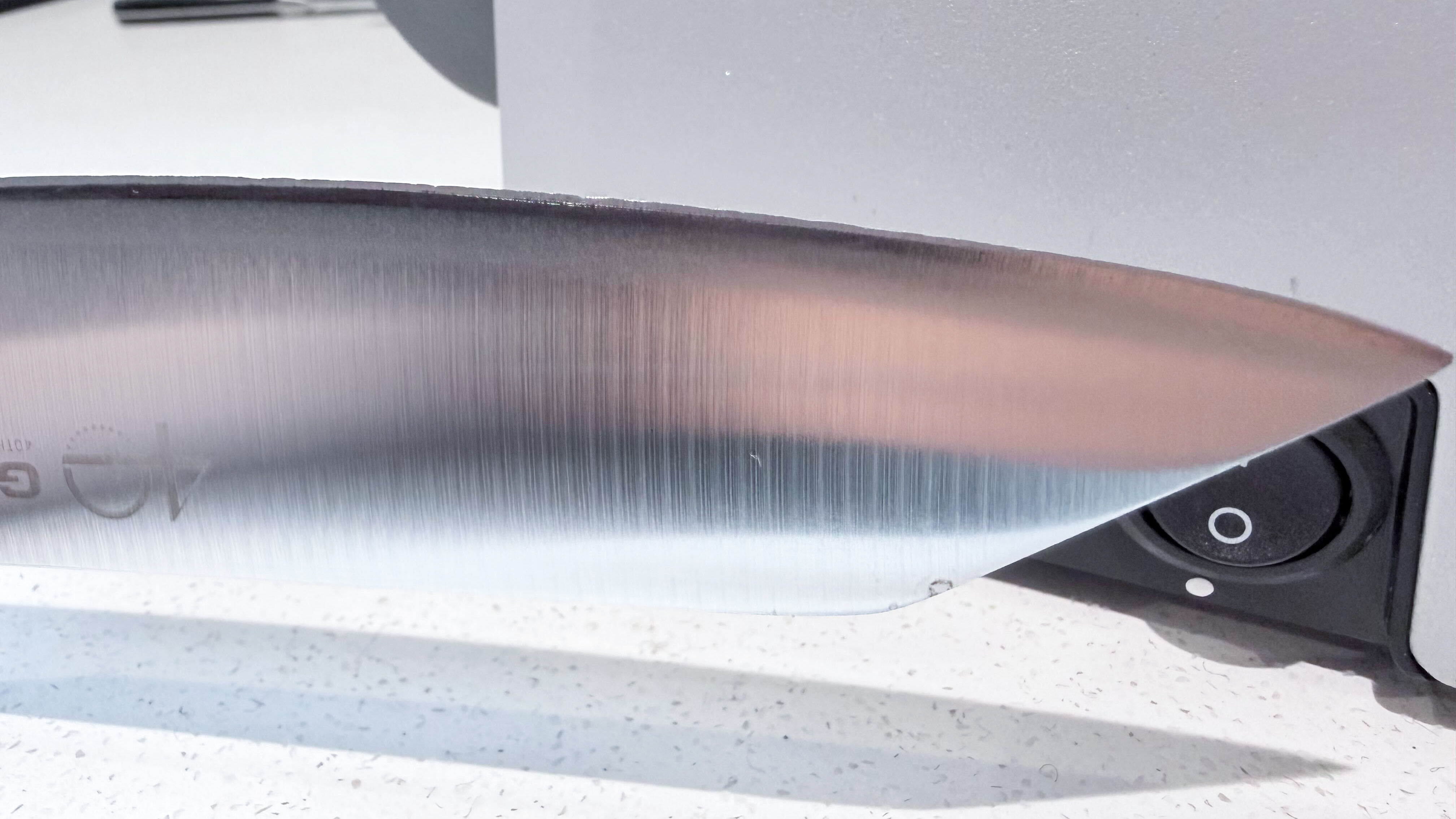
As you can see above, its edge was covered in sizeable nicks and needed metal grinding away with a new edge and bevel applied. It was in a pretty sorry state. (This is why I choose to use Wüsthof knives, as their steel and edge angles stand up much better to wear and tear.)
I set the Tormek T-1 to 10-degrees and ground the knife back to life. This took me around 15 minutes of grinding and honing.



As you can see from the third gallery photo above, there are a few minor nicks still visible, so it needs a few more passes next weekend. But the new edge still looks fantastic, especially after polishing on the honing wheel. I used the renewed knife for the first time a few hours later on some veg prep for a risotto — it was ferociously sharp, chopping through two punnets of mushrooms like they were nothing.
I even ran it along the top of my index finger and it shaved off all the tiny hairs! Talk about razor sharp.
Knife #3 — Victorinox chef's knife
Next up was the biggest problem case: my battered Victorinox chef’s knife, given to me on my first day of culinary school. Worth much less than my other knives (at least in financial terms) this poor little chef’s knife was already in a shabby state through general use and a lack of honing by others — mostly dull, with numerous nicks.
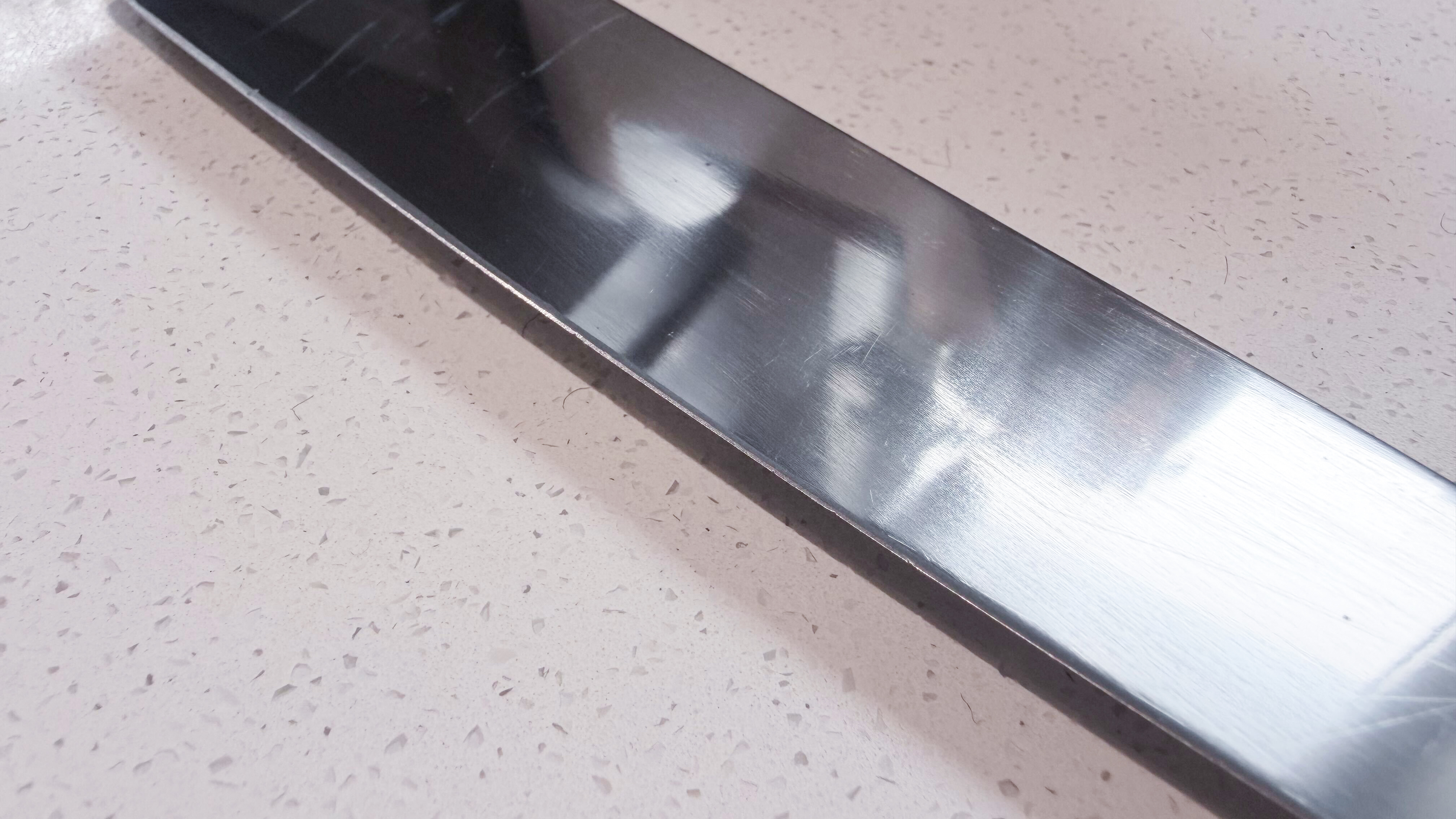
Then it had been subjected to my Wüsthof pull-through sharpener, which the steel and bevel angle were not designed for. The edge and bevel were absolutely destroyed in the process. The image above doesn't really do justice to the state it was in — it was totally jagged and sorry-looking.
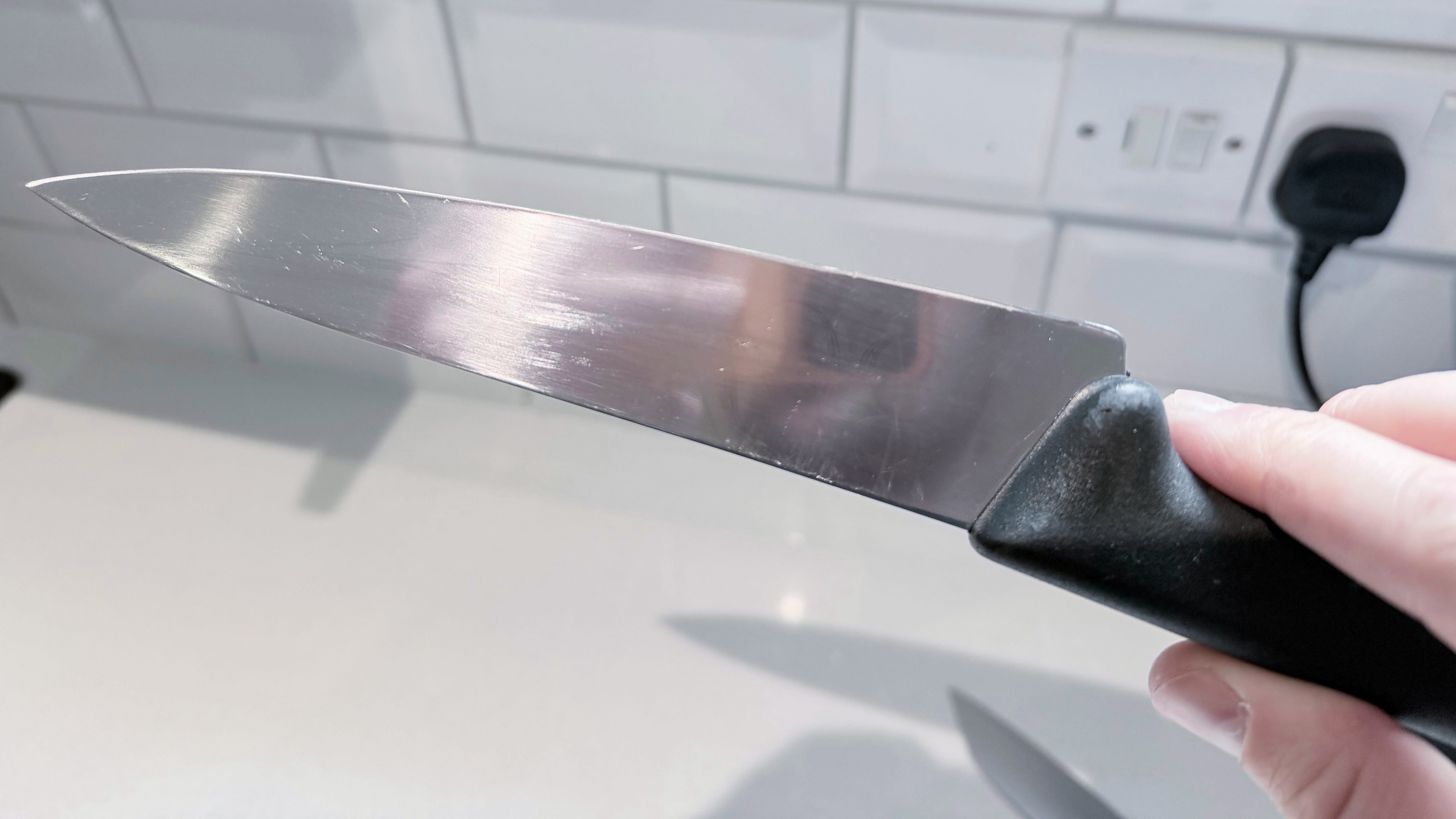
Restoring this knife took about 30 minutes and probably 40-or-so passes on each side, after which it was back in respectable shape. It isn’t perfect, and I still have work to do removing a few more deep nicks and getting the very base of the blade to match the rest. But hey, it’s way more usable now, and again savagely sharp.
A long-term investment
At $420 / £355, the Tormek T-1 is pricey, there’s no getting around it. But this tool is a long-term investment. Tormek tells me the T-1’s grinding disk is designed to last for 1,000 normal sharpenings (after which you can buy replacement wheels). Obviously, that doesn’t include the heavier repair work I’ve done, but if you use the T-1 regularly for honing and sharpening, the idea is that those instances will be rare one-off occurrences.
My go-to method for honing, sharpening and even repairing knives. The Tormek T-1 features a diamond grind wheel and composite honing wheel. It also features a knife guard to ensure you achieve the perfect angle each and every time.
$420 may seem like a lot now, but spread that cost over 10, 15, even 20 years, and the economics make a lot more sense. People like me buy expensive knives knowing they’ll last decades, and the same logic applies to the T-1. If you want the best for your knives, with as little fuss and variability as possible, I can’t recommend the Tormek T-1 highly enough.
Affordable alternatives
As I mentioned above, I think the T-1 is a solid long-term investment. It should last you many years without even needing to replace the grind wheel. Let's say you have it for 10 years before you need to replace the grind wheel — that's $42 a year to keep your knives in perfect condition.
However, I am well aware that it's still a lot of money to spend. If you can sacrifice some of the Tormek's ease-of-use and versatility, here are some alternatives for keeping those knives razor sharp.
If you're willing to put in some time and patience to perfect your technique, a traditional whetstone is a more affordable option than the T-1. Before I moved onto the Tormek, I used Wüsthof whetstones for any knives that weren't suited to my pull-through sharpener. This whetstone has three blocks for coarse, medium and fine, allowing you to reshape bevels and edges with a decent degree of control. It takes ages, though, which has always made me less inclined to use a whetstone.
If you'd prefer a quick and easy pull-through sharpener then I'd encourage you to buy something like this universal sharpener with two sets of different sharpening blades, one for European and one for Asian style knives. As I mentioned up top, though, these effectively plane away metal, so they can risk messing up your knife. If you can, I would recommend getting a pull-through made by your knife's manufacturer, as you know then it'll be designed for that steel.
If you're very confident in how accurate you can be at sharpening on a rod and maintaining the same angle each time, then a diamond steel rod like this will sharpen your knives very quickly. You use it like a normal steel rod, so it's incredibly easy to pick up and use. However, it's also extremely easy to get the wrong angle and, at best, apply an uneven edge, or at worst dull your blade completely.

Follow Tom's Guide on Google News and add us as a preferred source to get our up-to-date news, analysis, and reviews in your feeds.
More from Tom's Guide
- I pitted the new GoPro MAX2 against the Insta360 X5 — here’s my verdict
- IKEA released a $9 fridge organizer that will make your drinks look neat and tidy
- Spotify's recent missteps drove me to Apple Music — and I can't believe it took me so long

Peter is a Senior Editor at Tom's Guide, heading up the site's Reviews team and Cameras section. As a writer, he covers topics including tech, photography, gaming, hardware, motoring and food & drink. Outside of work, he's an avid photographer, specialising in architectural and portrait photography. When he's not snapping away on his beloved Fujifilm camera, he can usually be found telling everyone about his greyhounds, riding his motorcycle, squeezing as many FPS as possible out of PC games, and perfecting his espresso shots.
You must confirm your public display name before commenting
Please logout and then login again, you will then be prompted to enter your display name.
